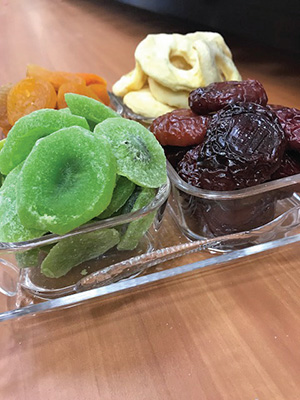


From an early age, children learn that Tu B’Shevat is the “birthday of the trees.” Stores stock up on dried fruit, and everyone learns a collection of upbeat songs that embrace the coming of spring in contrast to the freezing temperatures outside.
Tu B’Shevat is a day celebrated in many different ways. In Israel, it has become a day of national tree planting and environmental awareness (think of it as Earth Day meets Arbor Day). It is also the day used to calculate the halachic age of a fruit-bearing tree, in order to determine when fruit is allowed to be used.
Tu B’Shevat, though not mentioned in the Torah, has a multitude of spiritual and kabbalistic meanings. Kabbalistically, many would hold a Tu B’Shevat seder, similar in some ways to the Pesach seder. Many still have this tradition, complete with four cups of wine and specific fruits. But even those who do not have the custom of a Tu B’Shevat seder often wish to mark the day with a special meal focused around the meaning of the day.
Any fruit is fair game for celebrating Tu B’Shevat and dried fruits have become a staple of many Tu B’Shevat celebrations. If you’re looking to not just serve the fruit, but have kids involved, whether at home or at school, dried fruit is a wonderfully tactile tool for building a Tu B’Shevat centerpiece. Using skewers and clay pots, children can pierce the fruit and assemble them artistically (and eventually eat them, too). No clay pots available? Try using a citrus fruit cut in half and face down on a plate as your base, and proceed to stick the skewers into the fruit that way. Colorful and fruity smelling, these will brighten up any table.
For a more elegant centerpiece, many stores sell miniature potted plants. Pull the look of your seudah together with these small but attractive centerpieces. They have the added bonus of thematic decor, while still being short enough that guests do not need to shift awkwardly in order to talk to the person across the table.
A beautiful dried-fruit platter can serve as a table display and double as dessert. Joel Schiff, owner of Teaneck’s World of Goodies has been preparing for Tu B’Shevat with a large selection of dried fruit. It can be purchased loose for any projects that you have in mind, or already arranged, perfect for impressive hostess gifts or centerpieces.
For any meal, large or small, place cards make an elegant touch. Try getting creative with the shape of the card—maybe a tree silhouette, or varying shapes of the seven foods of Israel that are especially fitting for Tu B’Shevat. For added fun, the back of the place card can have a question or fun fact related to Israel, trees, fruit or any topic you decide to include.
Many stores also sell tiny seed pots. Using these as a place card has an added bonus of being both a place card and a giveaway.
Of course, Israel is not the only place that can plant trees on Tu B’Shevat. If someone is fortunate enough to be in Israel for Tu B’Shevat and can partake in a celebration there, that is wonderful. For the rest of us, we can still mark the day either by planting our own trees or sponsoring a tree planting in Israel. How many of us grew up with Jewish National Fund cards being mailed to mark a momentous occasion? Believe it or not, this still exists, and JNF still actively looks for sponsors to plant trees in Israel. Enjoy Tu B’Shevat and the meaning it brings in uniting Jews across the world, as we celebrate the fruits of Israel and all around the world.
By Jenny Gans










